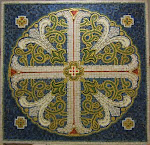When she had said this, she went back and called her sister Mary, and told her privately, ‘The Teacher is here and is calling for you.’ And when she heard it, she got up quickly and went to him. Now Jesus had not yet come to the village, but was still at the place where Martha had met him. The Jews who were with her in the house, consoling her, saw Mary get up quickly and go out. They followed her because they thought that she was going to the tomb to weep there. When Mary came where Jesus was and saw him, she knelt at his feet and said to him, ‘Lord, if you had been here, my brother would not have died.’ When Jesus saw her weeping, and the Jews who came with her also weeping, he was greatly disturbed in spirit and deeply moved. He said, ‘Where have you laid him?’ They said to him, ‘Lord, come and see.’ Jesus began to weep. So the Jews said, ‘See how he loved him!’ But some of them said, ‘Could not he who opened the eyes of the blind man have kept this man from dying?’
Then Jesus, again greatly disturbed, came to the tomb. It was a cave, and a stone was lying against it. Jesus said, ‘Take away the stone.’ Martha, the sister of the dead man, said to him, ‘Lord, already there is a stench because he has been dead for four days.’ Jesus said to her, ‘Did I not tell you that if you believed, you would see the glory of God?’ So they took away the stone. And Jesus looked upwards and said, ‘Father, I thank you for having heard me. I knew that you always hear me, but I have said this for the sake of the crowd standing here, so that they may believe that you sent me.’ When he had said this, he cried with a loud voice, ‘Lazarus, come out!’ The dead man came out, his hands and feet bound with strips of cloth, and his face wrapped in a cloth. Jesus said to them, ‘Unbind him, and let him go.’
- John 11:28-44
The story of Lazarus continues from yesterday's reading. In this part of the reading, we can see reflected the differing characters or personalities of the sisters, Martha and Mary. In the story from Luke, it is Martha who is busy with the chores and complains of her sister who sits listening to Jesus. In this story in the gospel of John, Martha comes out to meet Jesus on the road, while Mary is at home sitting in mourning - together with the other mourners. Again we have the difference in personality, with Mary taking the more "contemplative" role, and Martha the active one.
When Jesus meets Mary, she walks to him grieving and crying. The mourners follow her, thinking that she was going to the tomb of Lazarus. So Jesus is greeted by a group of people - Mary to whom he is so close and the mourners, who are all weeping. In this part of the story I view Jesus' empathic character. He weeps with those who are sad. His emotions are troubled because of his empathy with the sadness in this group of mourners and his friend Mary. Jesus' compassion is, in my opinion and my viewing of this text, invoked by the sadness of this company and he shares their feelings. This is the depth of his humanity - it is to share everything with us, our emotions as well, and the depth of empathy he has within him is so great that he is also moved to tears, despite the fact that he knows what he is going to do. He shares their sadness.
He knows that he is going to heal Lazarus. We are told that he thanks the Father for granting him his prayer - but again he does this for the benefit of the crowd. This is his teaching role. In all the action so far, his weeping and his pronouncement of thanks, he is thinking of the people who are with him - the living who need his help and with whom he is bonded in relationship and care and compassion. It is the depth of this compassion that we must note in today's reading. It teaches me that such depth of feeling in me or anyone else is nothing to be ashamed of. So often we are taught that this is a sign of weakness!
And finally, Jesus cries loudly: Lazarus, come out! Lazarus walks out of the tomb, his hands, feet and face still bound by the linens of death. We are told by ancient commentaries that this is symbolic that Lazarus will die a natural death eventually - he still needs the clothes of the tomb. This is contrasted with the linens of Jesus left behind in the tomb. There is also the symbolism of Jesus' voice calling those in the tombs to come out - his is the voice of resurrection, just as he healed the demoniac who lived among the tombs. But again, illumination: Lazarus walks out of the darkness and into the light; and freedom: Lazarus is bound by the linens of death, hand and foot and face, but these will come off and he will be freed.
From which binding do we need healing, freedom and illumination today? Do we share the compassion of Christ? Can we see in his friendship with these women and this man the depth of love and friendship he offers to us?







No comments:
Post a Comment